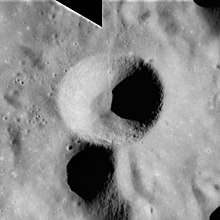Santos-Dumont (crater)
Santos-Dumont is a small lunar impact crater that lies in the northern end of the Montes Apenninus range at the eastern edge of the Mare Imbrium. It is located about 30 kilometers to the northeast of Mons Hadley, a mountain massif.
 Apollo 15 image | |
| Coordinates | 27.7°N 4.8°E |
|---|---|
| Diameter | 8 km |
| Colongitude | 356° at sunrise |
| Eponym | Alberto Santos-Dumont |
This crater is a circular, bowl-shaped formation that is situated atop a ridge in the Montes Apenninus. It is otherwise an unremarkable formation with no unusual features and little appearance of wear.
To the northwest of Santos-Dumont is a 90-km-wide system of rilles designated the Rimae Fresnel, being named for the Promontorium Fresnel that lies to the north of the crater. This last formation forms the northern end of the Montes Apenninus, and lies astride the gap that joins the Mare Imbrium to the west with the Mare Serenitatis to the east. To the southeast, in the valley past Mons Hadley, is the landing site of the Apollo 15 mission.
This feature is named in honour of the Brazilian aviation pioneer Alberto Santos-Dumont.[1] It was previously designated Hadley B.
References
- "Santos-Dumont (crater)". Gazetteer of Planetary Nomenclature. USGS Astrogeology Research Program.
- Andersson, L. E.; Whitaker, E. A. (1982). NASA Catalogue of Lunar Nomenclature. NASA RP-1097.CS1 maint: ref=harv (link)
- Bussey, B.; Spudis, P. (2004). The Clementine Atlas of the Moon. New York: Cambridge University Press. ISBN 978-0-521-81528-4.CS1 maint: ref=harv (link)
- Cocks, Elijah E.; Cocks, Josiah C. (1995). Who's Who on the Moon: A Biographical Dictionary of Lunar Nomenclature. Tudor Publishers. ISBN 978-0-936389-27-1.CS1 maint: ref=harv (link)
- McDowell, Jonathan (July 15, 2007). "Lunar Nomenclature". Jonathan's Space Report. Retrieved 2007-10-24.CS1 maint: ref=harv (link)
- Menzel, D. H.; Minnaert, M.; Levin, B.; Dollfus, A.; Bell, B. (1971). "Report on Lunar Nomenclature by the Working Group of Commission 17 of the IAU". Space Science Reviews. 12 (2): 136–186. Bibcode:1971SSRv...12..136M. doi:10.1007/BF00171763.CS1 maint: ref=harv (link)
- Moore, Patrick (2001). On the Moon. Sterling Publishing Co. ISBN 978-0-304-35469-6.CS1 maint: ref=harv (link)
- Price, Fred W. (1988). The Moon Observer's Handbook. Cambridge University Press. ISBN 978-0-521-33500-3.CS1 maint: ref=harv (link)
- Rükl, Antonín (1990). Atlas of the Moon. Kalmbach Books. ISBN 978-0-913135-17-4.CS1 maint: ref=harv (link)
- Webb, Rev. T. W. (1962). Celestial Objects for Common Telescopes (6th revised ed.). Dover. ISBN 978-0-486-20917-3.CS1 maint: ref=harv (link)
- Whitaker, Ewen A. (1999). Mapping and Naming the Moon. Cambridge University Press. ISBN 978-0-521-62248-6.CS1 maint: ref=harv (link)
- Wlasuk, Peter T. (2000). Observing the Moon. Springer. ISBN 978-1-85233-193-1.CS1 maint: ref=harv (link)
| Wikimedia Commons has media related to Santos-Dumont (lunar crater). |